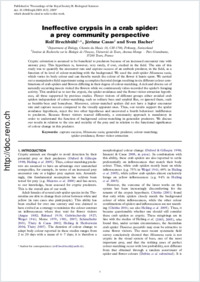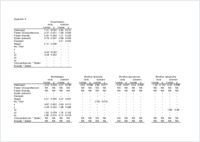Ineffective crypsis in a crab spider: a prey community perspective
- Brechbühl, Rolf Department of Biology, University of Fribourg, Switzerland
- Casas, Jérôme Institut de Recherche sur la Biologie de l'Insecte, Université de Tours, France
- Bacher, Sven Department of Biology, University of Fribourg, Switzerland
-
04.11.2009
Published in:
- Proceedings of the Royal Society B: Biological Sciences. - 2009, vol. 277, no. 1682, p. 739-746
capture success
Misumena vatia
generalist predator
colour-matching
spider avoidance
flower visitor attraction
English
Cryptic coloration is assumed to be beneficial to predators because of an increased encounter rate with unwary prey. This hypothesis is, however, very rarely, if ever, studied in the field. The aim of this study was to quantify the encounter rate and capture success of an ambush predator, in the field, as a function of its level of colour-matching with the background. We used the crab spider Misumena vatia, which varies its body colour and can thereby match the colour of the flower it hunts upon. We carried out a manipulative field experiment using a complete factorial design resulting in six different colour combinations of crab spiders and flowers differing in their degree of colour-matching. A rich and diverse set of naturally occurring insects visited the flowers while we continuously video-recorded the spider's foraging activity. This enabled us to test the crypsis, the spider avoidance and the flower visitor attraction hypotheses, all three supported by previous studies. Flower visitors of different groups either avoided crab spiders independent of colour-matching, such as solitary bees and syrphid flies, or ignored them, such as bumble-bees and honeybees. Moreover, colour-matched spiders did not have a higher encounter rate and capture success compared to the visually apparent ones. Thus, our results support the spider avoidance hypothesis, reject the two other hypotheses and uncovered a fourth behaviour: indifference to predators. Because flower visitors reacted differently, a community approach is mandatory in order to understand the function of background colour-matching in generalist predators. We discuss our results in relation to the size and sociality of the prey and in relation to the functional significance of colour change in this predator.
- Faculty
- Faculté des sciences et de médecine
- Department
- Département de Biologie
- Language
-
- English
- Classification
- Biology, life sciences
- License
-
License undefined
- Identifiers
-
- RERO DOC 12940
- DOI 10.1098/rspb.2009.1632
- Persistent URL
- https://folia.unifr.ch/unifr/documents/301260
Other files
Statistics
Document views: 106
File downloads:
- pdf: 150
- Supplementary material: 147

